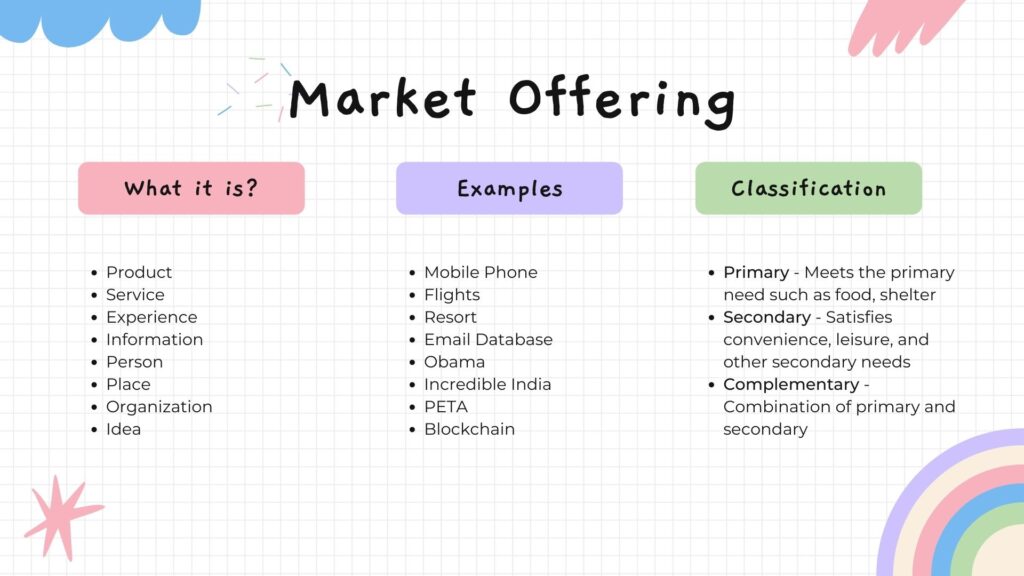What is a Market Offering?
It is a combination of products, services, information, or experiences offered to a market to satisfy a need or want. For example, in the food industry, a “market offering” might be a sandwich. More broadly, market offerings also include other entities, such as persons, places, organizations, information, and ideas. It doesn’t have to be only physical products (tangible), it can also be services/experiences (intangible). The aim of marketing is to create awareness about this market offering and thereby encourage consumers to purchase it from sellers.
How do you create a market offering?
The first step in creating a market offering is to determine the difference between your product and your competitors’ products. A market offering is when you make something easier for consumers to find or purchase. The new products and services should have a strong business purpose, meet consumer needs, be innovative in design and technology, competitively useful, different from competitors’ products or services that are already available on the marketplace – it comes with an edge over other products or provides superior customer service. A new product or service can turn a company’s market share from bad to good.
How to Price Your Market Offering?
The amount of value that is exchanged for a customer offering (i.e., its “market price“) can vary widely based on many factors including type and quality of the product/service, geographic location, raw materials, time period, seasonality, perceived value to consumers (e.g., low cost or high quality), product features (e.g., advertising), uniqueness/innovation (e.g., cutting edge technology), access to suppliers and other important players in a particular industry, brand name recognition/reputation, and even the legal status of the offering (e.g., whether it is protected by intellectual property rights).
Classifications
Market offerings can be classified as “primary” or “secondary“. Primary market offerings are those which supply a primary need or want, such as food for survival. Secondary market offerings provide convenience and/or leisure time activities, such as fast-food restaurants. Marketings with both primary and secondary benefits may be called “integrated” marketings. For example, in addition to satisfying basic human needs for survival and sustenance, local grocery stores also serve an important role in providing an economic and social infrastructure.
It is common for market offerings to be complementary (i.e., they satisfy a need or want that cannot be satisfied by another product, service, or idea). For example, selling both gaming consoles like PS4 and gaming titles like FIFA. In order to successfully compete in the marketplace, market offerings must be able to satisfy primary needs and secondary wants simultaneously. For example, it is common for grocery stores to provide both food items as well as items that are used for leisure activities such as reading books or playing games.

What if there is a little fit between the company’s market offerings and the needs of which customer group?
In this case, the business will need to adjust its marketing strategy in order to meet customer needs. This can be done by either enhancing or removing features from products and services. Moreover, the business can also modify its pricing and promotional strategies.
What is the Difference Between Market and Commercial Offering?
A market is an entire group of people or organizations that share common needs or wants; a commercial is for sale to only one buyer at a time. A business may offer its products and services to multiple markets (for example: global). But most businesses do not operate in more than one market at once.
Conclusion
Market offerings are not designed to solve problems, but to highlight the value of your product or service. If you use them as an end in itself, they can easily become confusing and lose their effectiveness. To be more effective with market offerings, you need to think about how they fit into your overall strategy. Do you want them to complement other marketing tactics? Do they play a role in solving customer problems? They’re also a great way to gain attention and build awareness about your brand, but they shouldn’t be the only marketing strategy you use. If you focus too much on market offerings, it will lead to marketing myopia; this is when you stop thinking about what your customers want and instead focus on what you think they should want.
